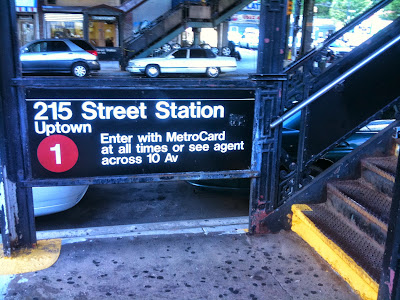Exploring the stations along the IRT Broadway line in the Northern tip of Manhattan and the Bronx, Greig Roselli's mind wanders.
The Harlem River swallows five Manhattan city blocks. The streets are numbered up to 220th on the mainland of Manhattan, but in Marble Hill, across the Broadway Bridge, the numbers begin at 225th street, as if the river itself is a five block wide gape. I like to think of it that way, anyway; on a map, the river looks like a bluish slab of concrete anyway; or maybe there was a 222nd street in Manhattan - if there was, I wonder what it was like? Did they have bodegas and subway stations? As for 221st, 223rd, and 224th, they are gone too - kinda repositioned into some region of the Bronx or even Queens, but here in Inwood, peering over the expanse, the blocks have vanished. Maybe the civic designers marked the streets this way to note the transient nature of the island's geography. Streets that are marked now may not exist in the future, the shift of the river, or global warming climate changes, change the nature of the landscape. New York City will not be the same geographically in 2100, as it is today. Lower Manhattan, according to an exhibit, Rising Currents, currently on display at MoMA this summer, will be akin to Venice, sans the gondolas.
My mind is on permanence and transience, as I wander the northern part of Inwood.
The local 1 train veers off of Broadway and follows 10th avenue in Inwood.
The els are menacingly loud. New Yorkers travel these rumbling god-trains; their appearance is a swift apparition of noise and wind. A South Ferry Bound train rumbles above of me as I walk along the tenth avenue to get a clandestine peek at the Transit Authority train yards that lie to the East of Inwood. Condominium towers lie in the Distant Bronx. From here, you can see how thin the northern tip of Manhattan island really is.
A buxom blonde woman guards the train yard gate. She catches me snapping pictures. I am surprised how politely she asks me to stop. "Sir, you can't take pictures of the trains. It's illegal." I am - for a moment - afraid a more buxom employee will appear from behind the grill and confiscate my camera, so I tuck it neatly into my pants pocket and walk on, disappointed that I cannot continue to peer into the sinuous rills of the train yard. Sometimes when I am among the tracks of mass transit, I become giddy. I am not the only one. Just last night, I was riding the Pelham Bay local towards my Queens-bound transfer on the R train. A man and his son were sitting near me and I was amused by the son, who was obviously visiting New York, because in the midst of their conversation he cries, "I love the subway." He got up from his seat and started to almost skip down the train aisle, but his father grabbed him and told him to sit down. He was greatly amused by the mechanics of the journey, repeating the words of the conductor to his father, and lovingly looking out the window into the subterranean blackness of the underground.
The train system is infinitely fascinating (which is why I write about it). I am interested in the intersection of people and movement. The way the system moves people around; how we move around in the system; how we interact and how we are engaged. Some of us are docile travelers, hardly noticing the whir that surrounds us, but others are like the boy on the Pelham Bay local, gesticulating with the gesture of energy along with the movement of the train. He understood the mystery of the system, how it is like a cipher, something mysterious, yet so full in the midst of millions of people. The subway city as a cipher is akin to the ancient image of the labyrinth, with its routes and tunnels overlapping and turning, but never getting anywhere, only presenting choice decisions along the way.
Would you like to read more? Fetch Greig Roselli's book of essays, Things I Shouldn't Have Said (And Other Faux Pas) for more good writing, dammit.
Subscribe to the RSS Feed of Stones of Erasmus
 |
| Entrance to the 215th Street Elevated IRT Station in New York |
My mind is on permanence and transience, as I wander the northern part of Inwood.
The local 1 train veers off of Broadway and follows 10th avenue in Inwood.
The els are menacingly loud. New Yorkers travel these rumbling god-trains; their appearance is a swift apparition of noise and wind. A South Ferry Bound train rumbles above of me as I walk along the tenth avenue to get a clandestine peek at the Transit Authority train yards that lie to the East of Inwood. Condominium towers lie in the Distant Bronx. From here, you can see how thin the northern tip of Manhattan island really is.
 |
| Subway Train Yard in Manhattan |
The train system is infinitely fascinating (which is why I write about it). I am interested in the intersection of people and movement. The way the system moves people around; how we move around in the system; how we interact and how we are engaged. Some of us are docile travelers, hardly noticing the whir that surrounds us, but others are like the boy on the Pelham Bay local, gesticulating with the gesture of energy along with the movement of the train. He understood the mystery of the system, how it is like a cipher, something mysterious, yet so full in the midst of millions of people. The subway city as a cipher is akin to the ancient image of the labyrinth, with its routes and tunnels overlapping and turning, but never getting anywhere, only presenting choice decisions along the way.
Would you like to read more? Fetch Greig Roselli's book of essays, Things I Shouldn't Have Said (And Other Faux Pas) for more good writing, dammit.
Image Source: © 2010 Greig Roselli
Subscribe to the RSS Feed of Stones of Erasmus


